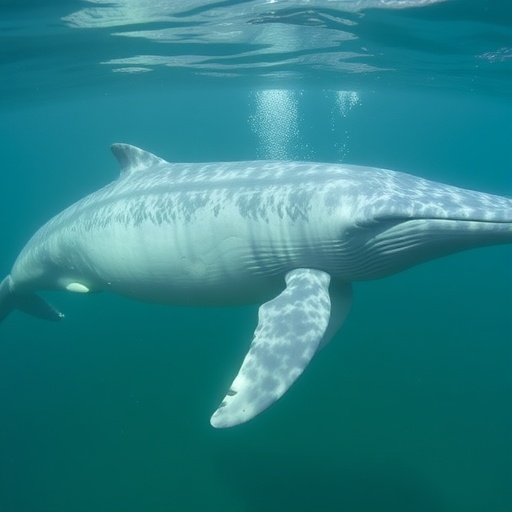In a groundbreaking environmental discovery, researchers from Stockholm University and the Swedish Museum of Natural History, together with their scientific partners in Greenland and Canada, have identified a novel class of poly- and perfluoroalkyl substances (PFAS) embedded deep within the blubber of killer whales. This revelation challenges decades of assumptions about how these persistent and pervasive chemicals interact with wildlife, adding a new dimension to our understanding of contaminant behaviors in marine ecosystems.
The new study, recently published in Environmental Science & Technology Letters, unveils the presence of five fluorotelomer sulfones—chemical compounds characterized by their extensive fluorination and lipophilic properties. Unlike most PFAS compounds well-documented in environmental toxicology, which predominantly accumulate in protein-rich tissues such as the liver and blood, these fluorotelomer sulfones demonstrate a strong affinity for fat-rich blubber. This significant finding overturns the long-held belief that PFAS mainly bind to proteins, spotlighting a previously overlooked subset of neutral, fat-soluble PFAS molecules.
Lead author Mélanie Lauria, formerly a doctoral researcher at Stockholm University’s Department of Environmental Science and now a scientist at Switzerland’s Swiss Federal Institute of Aquatic Science and Technology (EAWAG), elaborates on the importance of the findings: “Our research is the first to demonstrate that highly fluorinated PFAS compounds can preferentially accumulate in fatty tissues. Historically, PFAS studies have centered on charged, polar molecules interacting predominantly with proteins; however, we now realize that neutral PFAS molecules, capable of dissolving within lipids, have been flying under the radar.”
Applying advanced mass spectrometry techniques, the research team meticulously analyzed tissue samples from killer whales hunted in Greenland and Sweden. The analytical precision of high-resolution mass spectrometry allowed the detection and quantification of fluorotelomer sulfones constituting up to 75 percent of total fluorine-containing substances in the blubber samples—a staggering indication of their abundance. Notably, these compounds were absent in liver samples from the same individuals, underscoring their unique lipophilic nature.
This distinct partitioning behavior between blubber and liver tissues reveals previously unknown pathways of PFAS bioaccumulation in marine mammals. With blubber comprising nearly 50 percent of a killer whale’s total body mass, the implications are profound. Co-author Jonathan Benskin, a professor at Stockholm University, stresses that “excluding fat-soluble PFAS from environmental monitoring may result in a gross underestimation of the total PFAS body burden in marine mammals. Blubber’s sheer volume magnifies the potential impact of these chemicals on apex predators.”
The discovery has far-reaching consequences for environmental toxicology, particularly concerning Arctic food webs. Marine mammals in the polar regions are apex predators and crucial components of indigenous diets; thus, understanding the full spectrum of PFAS contamination is essential for assessing risks to both wildlife and human health. The authors call for an expanded monitoring framework that includes lipid-associated PFAS compounds to more accurately assess contaminant exposure across trophic levels.
Exploring further, the study sheds light on the chemical nature of fluorotelomer sulfones. These substances belong to a class of PFAS characterized by fluorinated carbon chains with sulfone functional groups, resulting in highly stable, inert molecules. Their neutral charge accounts for poor affinity toward proteins but enhanced solubility within neutral lipids, such as those found in marine mammal blubber. This breakthrough contributes to the growing recognition of PFAS molecular diversity and the necessity to consider chemical properties beyond the classical protein-binding paradigm.
Environmental scientists frequently grapple with the analytical challenges posed by PFAS detection, considering their extensive variety and the complexity of biological matrices. The application of cutting-edge mass spectrometry methodologies in this study exemplifies the vital role of technological advancements in uncovering hidden contaminants. As these techniques evolve, they empower researchers to probe chemical landscapes previously inaccessible, unveiling subtle but critical contaminant distributions within organisms.
Furthermore, the identification of fluorotelomer sulfones in wildlife raises new questions regarding their origin, fate, and ecological impacts. These compounds may arise from the degradation of industrial fluorotelomer-based products, indicating ongoing environmental inputs despite regulatory efforts to curb PFAS emissions. The persistence and bioaccumulation of fat-soluble PFAS in marine mammals suggest potential toxicological effects that have yet to be fully elucidated, warranting rigorous ecotoxicological investigations.
From a regulatory perspective, the study’s findings underscore the urgency of revising existing monitoring guidelines and risk assessments to incorporate emerging classes of PFAS. Current protocols predominantly target water-soluble, protein-binding PFAS, potentially overlooking significant exposure pathways. The inclusion of fat-associated compounds would enhance the ecological relevance and protective capacity of environmental regulations aimed at safeguarding Arctic ecosystems and human communities reliant on marine resources.
Indigenous communities in Greenland played an instrumental role in this research by facilitating the ethical and legal collection of whale tissue samples through subsistence hunting practices. Collaborative efforts that respect indigenous knowledge and practices are essential for fostering trust and ensuring the sustainability of scientific investigations in sensitive environments. Moreover, these partnerships highlight the interconnectedness of environmental health and cultural traditions in the Arctic.
In summary, this landmark study propels the scientific community toward a more nuanced understanding of PFAS contamination, illuminating the critical need to examine the chemical landscape beyond traditional frameworks. The discovery of fat-soluble fluorotelomer sulfones concentrated within killer whale blubber not only redefines PFAS bioaccumulation patterns but also challenges existing paradigms, laying the groundwork for future research and policy development aimed at mitigating the impacts of these persistent pollutants.
The pioneering nature of this research exemplifies how interdisciplinary collaboration, innovative methodologies, and inclusion of indigenous participation can unravel complex environmental phenomena. As the Arctic continues to undergo rapid environmental change, elucidating the dynamics of emerging contaminants within its apex predators becomes increasingly vital for the protection of fragile ecosystems and the health of communities intertwined with this unique environment.
Subject of Research: Animal tissue samples
Article Title: “Discovery of Fluorotelomer Sulfones in the Blubber of Greenland Killer Whales (Orcinus orca)”
Web References: DOI: 10.1021/acs.estlett.5c00516
Image Credits: Anna Roos, Swedish Museum of Natural History
Keywords: PFAS, fluorotelomer sulfones, killer whales, blubber, lipophilic contaminants, marine mammals, Arctic pollution, mass spectrometry, environmental toxicology, bioaccumulation, persistent organic pollutants




